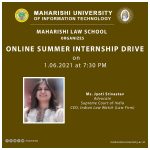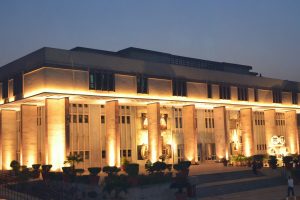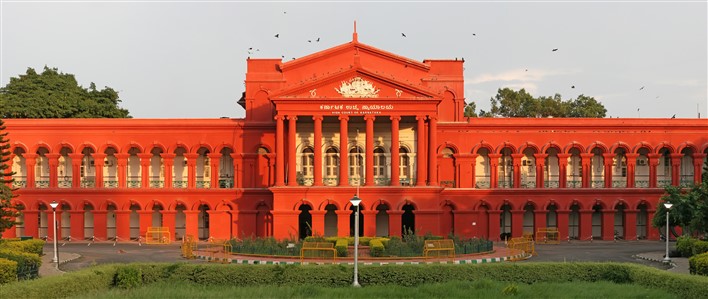ACCESS TO JUSTICE
Justice DY Chandrachud, struck the chord with every Indian by speaking on “Future of Virtual Courts and Access to Justice in India” in a webinar, organized by the Nyayam Forum of the NALSAR University. According to him, the Open Court system is the “spine” of our legal system and cannot be displaced by the virtual court system. The virtual court system had to be resorted to on account of the unprecedented COVID-19 pandemic but these hearings are not a substitute for the open Court system.
Access to justice is a basic principle of the rule of law. In the absence of access to justice, people are unable to have their voice heard, exercise their rights, challenge discrimination or hold decision-makers accountable.
The Rule of Law emphasizes the right of equal access to justice for all, including members of vulnerable groups. The state should take all necessary steps to provide fair, accessible, transparent, effective, non-discriminatory and accountable services that promote access to justice for all at all times.
Access to justice means:
- In the narrowest sense would include right to appear before the court.
- Advocacy including for those who cannot afford it. The definitions of access to justice should be focused on “practising law for poor people”. The goal to provide legal representation to impoverished individuals who could not otherwise afford legal advice.
- Reforming the justice system: This approach encompasses elements from the other approaches, including the use of simplified court procedures, alternative dispute resolution and other measures in an effort to solve legal problems before they get to a litigation stage.
-
The Future of Access to Justice: Where is the concept of “access to justice” is headed next? Critics of current access to justice initiatives have called for societal change beyond the legal realm, by encouraging the justice system to develop partnerships with communities.
Furthermore, on May 15, less than two months since the implementation of the lockdown, under the aegis of Chief Justice S A Bobde and Justice D Y Chandrachud, the Supreme Court rolled out a system of electronic filing. The demonstration of the electronic filing system was made live on YouTube for every lawyer in the country to access. With the new electronic filing system, a case can be filed from any part of the country and at any time. Court fees can be paid and defects to the petitions can be pointed out and cured online. A lesson for future incorporation to simplify procedures.
According to Justice Chandrachud, there are THREE fundamental principles on which, the interface between technology and the judicial process should be based :
· Technology that enhances justice to the common citizen.
· Technology as an intrinsic element of the rule of law.
· Justice not just as a sovereign function but as a service that is provided to the community.
Your Lordship quoted Susan Hood, Chief Executive of Her majesty’s Courts and Tribunal Service in the UK, who said that “Our processes don’t need to be as old as our principles. Technology must at its core be about enhancing access to justice.” Today’s pandemic has alerted everyone the need to accelerate the pace for incorporation of technology and also the present best practices can also be adopted post the normal condition is resumed.
COVID crisis changed a lot. The functioning of the Courts changed in various ways due to the pandemic and the nationwide lockdown. The number of lawyers permitted in courtrooms was limited and video conferencing for conducting urgent hearings was adhered to. The criminal justice system however cannot function without Courts.
Your Lordship stated that the functioning needs to be increased, and even if open courts are started again, the long-term goal of the e-courts project is to ensure that all courts in India are capable, where and when necessary. This observation needs special attention for the subordinate judiciary and common litigant.
The CJI announced that virtual courts are here to stay and “there is no looking back”. The future will be a combination of physical and virtual courts which is a good achievement for all of us considering the time a lawyer spends on-road and managing dates to shuttle between courts.
Justice Chandrachud who is also the Chairman of the E-committee stated that technology should be used for inclusive justice. According to the data, a large section of the people still do not have access to technology and the internet and hence, it is important to ensure that this technological divide does not become a means of exclusion.
While concluding, he also stated that the current situation can be made into an opportunity to bring in change.
“let us convert a very difficult situation into an opportunity for change, changes occur in the most difficult of situation, humanity across the world and India is confronted with a public health crisis of unprecedented dimensions, that gives us an opportunity to bring fundamental transformation to provide better service to our citizens and have a pan India collaboration with civil society and with different segments of the legal profession to provide good service under a robust technological infrastructure,” he said.
QUOTE BYTES ON VIRTUAL SYSTEM
“Virtual courts are open courts too and that cannot be described as closed or in-camera proceeding.”
“We went for video conferencing to reduce the footfall in court premises. We have to change according to the needs of the times. We have to accept the present situation. There is a need for a change of mindset. Now there is no going back,”
Hon’ble Chief Justice of India, Justice Bobde
Video Clip 1: International Adoption of the Online System for dispensation of justice
SUPREME COURT OF INDIA PRACTICE DIRECTIONS FOR PANDEMIC
- The Hon’ble Bench(es) constituted to hear only matters involving extreme urgency, to be decided by the Hon’ble Presiding Judge of such Bench(es) on the basis of prayer made by Advocate-on-Record/party-in-person by way of a signed and verified application containing a synopsis of extreme urgency not exceeding one page, similar to urgency affidavit filed during Court Vacation periods. The said application shall be submitted only by e-mail sent to mention.sc@sci.nic.inlatest by 2:00 pm on the day preceding the day of the sitting of the Hon’ble Bench.
- The application must inter-Alia clearly contain the case-details, contact-details of the AOR/party in-person including e-mail id, mobile number and alternate number(s), camp/office address with Pin Code and Police Station, together with a prayer for exemption from filing duly affirmed affidavit in the prevailing circumstances with an undertaking that deficit court fees will be paid subsequently.
- The application must also contain a separate paragraph giving consent that the matter may be taken up through the Video-Conferencing mode. In the application, the AOR/Party-in-Person must specify as to whether he would link through own desktop/mobile or would prefer to appear at such facility in the Supreme Court premises;
- The entry into the High-Security Zone be further regulated by suspending entry of Learned Advocates on the basis of their proximity cards, till further orders;
- The Advocates having offices/chambers in the various Lawyers Chamber Blocks situated in the Supreme Court were advised against attending their respective offices/chambers, as they would require to be closed due to lack of cleaning and conservancy services, in light of the steps taken pursuant to the Government notification, as aforesaid;
- For the purpose of video-conferencing, the app ‘Vidyo’ may be downloaded on personal desktop/laptop/mobile device by clicking download link available on http://ecourtvc.nic.in. The “Vidyo” application can also be downloaded from Google Play Store for Android phone and from Apple Store for iOS phone. The AOR/Party-in-Person may refer to Standard Operating Procedure (SOP) uploaded on the website of the Supreme Court for assistance in this regard;
- Upon approval of the urgency by the Hon’ble Presiding Judge of the Bench, the case(s) would be enlisted in the cause-list to be published on the website by evening hours on the day preceding the sitting of the Bench; in case the application praying for listing on grounds of extreme urgency is not allowed, the AOR would be permitted to make oral mentioning before the Hon’ble Presiding Judge, over the landline phone at His Lordship’s residential office strictly between 10:30 am and 11:00 am on the day of the hearing; if upon such mentioning, the matter is allowed, the same would be listed as per directions of Hon’ble Judge. The list of telephone numbers of the Hon’ble Judges was made available on the website of the Supreme Court of India i.e. www.sci.gov.in.
- In all cases taken on the board, an intimation regarding the time of sitting of the Hon’ble Bench and approximate time of the hearing of their case(s) shall be sent to the concerned AOR/Party-in-Person on the Mobile Number and e-mail as mentioned in the application. The concerned AOR/Party-in-Person would also be provided a one-time link for such hearing, that would facilitate their participation in the hearing of the case as and when the same is conducted by the Hon’ble Bench. It is, therefore, desired that the AOR/Party-in-Person must keep his mobile free around the time indicated, as the Supreme Court Registry will call on the mobile number mentioned in their application when the matter is to be called for hearing through video-conferencing, as per cause-list;
- If the Advocate/Party-in-Person is unable to connect through video-conferencing due to non-availability of hardware/network on any given date, the matter would be listed on the next date of the sitting of any Bench and the AOR/Party-in-Person may appear through Video-Conferencing facility being made available in the Supreme Court premises. The Advocate/Party-in-Person may avail the facility of video-conference by approaching the video-conference room by indicating in the application their desire to do so.
- With a view to streamlining the access to members of the Press, the Deputy Registrar(Public Relations Officer) may permit only 3 media persons to remain inside the Video-Conference Room, whenever the Hon’ble Bench may sit to take up extreme urgent matters, till further orders;
Video clip 2 of Sacramento Country Court in Pandemic
COVID DIRECTIONS FROM VARIOUS HIGH COURTS IN INDIA
The Hon’ble the Chief Justice of the Bombay High court has been pleased to exempt the Advocates appearing before the High Court of Bombay and its Benches and the High Court of Bombay at Goa from wearing a black coat and Advocates’ gowns; they may wear tie or white band ensuring proper decorum before the Virtual Courts, till further orders.
In addition to, the Hon’ble Chief Justice of Chennai has taken notice of the Notification dated 1st of May, 2020 issued by the Ministry of Home Affairs, Government of India, New Delhi was pleased to direct that the judicial functioning of the High Court, both at Principal Seat and at Madurai Bench, shall be conducted strictly through video-conferencing only and the e-filing / e-mail filing system, as was being done before subject to all the prescriptions additionally provided in the aforesaid Notification of the Ministry of Home Affairs restricting movement in Containment Areas.
3. Delhi High Court

NOTIFICATION FOR FUNCTIONING OF SUBORDINATE JUDICIARY
- Uttar Pradesh

2. Delhi

LITIGANT STRESS
Accessibility is a core function of justice and today with functionality limited to urgent matters which not many potential litigants can access it. Time and tide cannot decide the applicability of the rule of law in a democratic nation. For that, the pillars of democracy are essential for proper functioning at all times.
New normal has put access to justice for a larger number of people at bay. However, enough measures have been taken to secure the rights of citizens are protected in the trying times.
Many people do face significant constraints in their effort to access justice even in normal times. Generally, many times people do not have the financial means to physically reach courtrooms or hire lawyers. Others cannot afford the opportunity cost of missing work to attend court. Then there is the issue of many of our courts being inaccessible to people with disabilities. Despite all these obstacles, even if people attend a hearing, there is a possibility that it will be adjourned. The new normal way of court functioning can in the near future aid the litigant more and make suitable changes in their approach to view access to justice with a difference.
Furthermore, the subordinate judiciary where all the litigation arises needs a special brainstorming presently for its functioning as the litigants cannot access the same now. This can have larger consequences besides adding pendency. Extending the limitation can give immunity over procedural consequences but not relief from emotional stress looking for justice.
This is also the right time to give access to justice to a litigant by exploring the alternate dispute resolution system as part of the multi-door justice system.













Add Comment